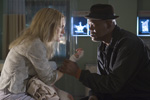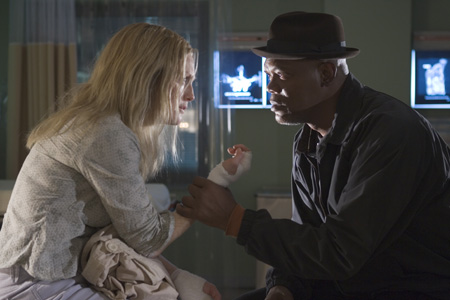Freedomland
 So I thought, “Julianne Moore… missing kid… What is this, ‘The Forgotten 2’?” That it was not… But I couldn’t quite figure out what else it was trying to be. What initializes as a story about a missing kid becomes a mishmash of subplots between the angry cop brother (Ron Eldard as Danny Martin) who wants justice, the creepy “Friends of Kent” consultant—i.e. finder of lost children—Karen Collucci (Edie Falco), the seemingly drugged out Brenda Martin (Moore) and the residents…
So I thought, “Julianne Moore… missing kid… What is this, ‘The Forgotten 2’?” That it was not… But I couldn’t quite figure out what else it was trying to be. What initializes as a story about a missing kid becomes a mishmash of subplots between the angry cop brother (Ron Eldard as Danny Martin) who wants justice, the creepy “Friends of Kent” consultant—i.e. finder of lost children—Karen Collucci (Edie Falco), the seemingly drugged out Brenda Martin (Moore) and the residents…

FREEDOMLAND, a Columbia Pictures release. Photo Credit: Frank Masi
So I thought, “Julianne Moore… missing kid… What is this, ‘The Forgotten 2’?” That it was not… But I couldn’t quite figure out what else it was trying to be. What initializes as a story about a missing kid becomes a mishmash of subplots between the angry cop brother (Ron Eldard as Danny Martin) who wants justice, the creepy “Friends of Kent” consultant—i.e. finder of lost children—Karen Collucci (Edie Falco), the seemingly drugged out Brenda Martin (Moore) and the residents of the Armstrong housing project in Dempsy, New Jersey.
Part of the problem is that the film seems like it’s directed by five different people — jumping around and never settling on one narrative or style. From the stock-erratic opening titles with the jarring noises, shaky camera and credits on mandatory graphic overload, I thought maybe this would be some sort of action-suspense thing. Just then, though, we see Brenda entering a clinic. There’s no dialogue but her hands are bloodied. It turns out she’s the victim of a carjacking and, worse, her child was in the car.
She lives in the blue-collar Gannon, bordering Dempsy, but works with the children of residents of the Armstrong projects. When she implies that the carjacker was black, hell rains down on Armstrong from the predominantly white police force. Now all of a sudden, this film wants to discuss the anatomy of racism — a bad idea when one isn’t prepared to dive into the psychology of it beyond superficial and rudimentary exploitation.
While a woman mumbles in the clinic, behind Detective Lorenzo Council (Samuel Jackson), and another patient continues to yell at the woman, Brenda relates the events to Council, who serves the Armstrong community. Council starts grilling her in a herky-jerky bit of editing and loud score that disorients you. I didn’t think it made sense but then Council, we discover, is an asthmatic…. Maybe the director was trying to convey that sense of agitation.
Brenda’s brother, Danny (Eldard) arrives at the clinic and, oddly, accosts Detective Council. There are several artificially-ramped confrontations throughout the film, which eventually erupt into full-scale pandemonium on both individual and collective fronts, the most prominent of which is the forced lockdown of the Armstrong community.
Possible Spoilers: There was an interesting story developing, about the psychoses of someone who loses a child, but it’s lost amidst the cacophony of the race-relations subplot. Also confusing is the addition of the story involving the “Friends of Kent” support group of whose assistance Lorenzo initially declines. This is always a sign, when it’s a prominently featured freelancer, that the protagonist will come back to them for help when he’s exhausted his other options. Having them mysteriously follow Lorenzo and Brenda around in a red truck (which some may expect is Danny’s) doesn’t serve any purpose other than to obscure their part in the film until act two, purely for false tension and nothing else. Most of what Karen brings to the table are platitudes, but then support group people can often possess that kind of banal fervor where patience and analytical thinking are of far more use to the cause than are appeals to emotion.
The film descends briefly into the requisite, “What I wouldn’t do for my child” speech followed dutifully by the “there’s a purpose to everything” rebuttal by Council. The problem is, when the twist of this film comes, and there is one, it doesn’t seem of any more consequence to us than anything else that happens. This is mostly because our senses are bombarded either with yelling matches between police and residents, or with characters not fleshed out enough.
Consider Lorenzo and his son Jason, who’s serving two years time in the state penitentiary for robbery. This is the extent of what we know about Jason, and all we know of their relationship is that Lorenzo wasn’t there for his son. That’s as complex as any of the characters get in this film. Sequences I might have otherwise found interesting were rendered powerless by the simple fact that you just don’t have a reason to really care about any one of the characters. This is particularly relevant as the film unfolds because of what you’re left with at the end. If you don’t believe the characters and their relationships mean something, then you’re left with a movie that made a lot of noise for ultimately nothing.
It’s interesting to note the producer cast Julianne Moore very early in the process. This suggests to me that the role and the story were further built out, but only so much, around her — conformed to Moore’s needs and not the story’s. That’s the way a lot of pictures are made, but it usually results in extremely poor storytelling. Everything feels shoehorned or shuffled around to satisfy one person. In this case, it culminates in a lengthy confession that the director, Roth (who spent 99% of his career being a producer, and the other 1% directing “Christmas With the Kranks”), seems to want to tilt it toward art. Yet, the scene, which drags on for ten minutes more than it needs to, emulsifies at room temperature, i.e nowhere near as haunting as Hans Beckert’s testimony before the undeground tribunal in Fritz Lang’s “M” — images that, once there, you can’t erase from your mind.
Real tensions would arise (and thus be subsequently released) if we felt there were something actually at stake here, but we can never be sure whose chain is being yanked — it could very well be ours.
 Freedomland • Dolby® Digital surround sound in select theatres • Running Time: 112 minutes • MPAA Rating: R for language and some violent content. • Distributed by Sony Pictures Releasing
Freedomland • Dolby® Digital surround sound in select theatres • Running Time: 112 minutes • MPAA Rating: R for language and some violent content. • Distributed by Sony Pictures Releasing